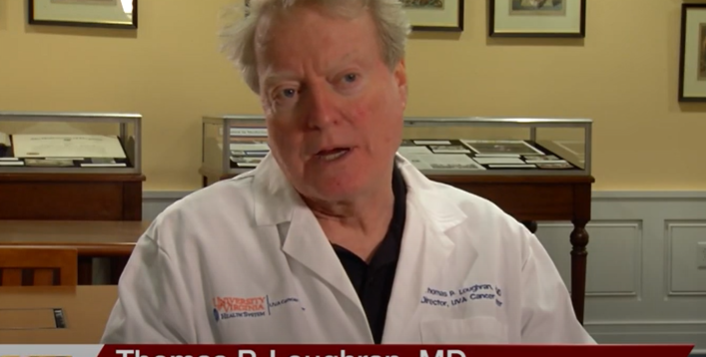Dr. Thomas P. Loughran, MD, Professor of Medicine and Director of UVA Cancer Center talks about a new life-changing treatment for patients with a rare form of cancer called LGL Leukemia.
Interview conducted by Ivanhoe Broadcast News in May 2022.
What is happening when someone has leukemia?
DR LOUGHRAN: Leukemia refers to generally an excessive production of white blood cells. The bone marrow where all the blood cells are made consists of red blood cells, white blood cells, and platelets. It’s very complicated, but there’s one simple way of looking at leukemia. It’s whether it’s an acute leukemia or a chronic leukemia. And then, the second division is to where the cells arise from. Do they arise from what we call myeloid cells or lymphoid cells? So, there’s basically four kinds of leukemia – acute lymphocytic leukemia, acute myelogenous leukemia, chronic myelocytic leukemia, and chronic lymphocytic leukemia. That’s kind of a simplified way of looking at it. But generally, the problem is the bone marrow is making too many white blood cells either very quickly, in which case the patients are sicker and there’s an acute leukemia, or very slowly and it’s a chronic leukemia.
Does treatment vary depending on the type?
DR LOUGHRAN: Yeah, treatment is extremely complicated even within the individual kind of leukemia.
What is LGL leukemia?
DR LOUGHRAN: It’s very much a rare disease. LGL stands for what the cells look like. So, they’re large, they have these granules in them, and they’re a kind of white blood cell called a lymphocyte. We started using this term when I was a fellow in Seattle at the Fred Hutchinson Cancer Research Center, where we originated the term of LGL leukemia. This is a clonal proliferation of these normal cells, LGL cells. Clonal means one cell becomes abnormal. It copies itself very slowly, but over and over again. It’s a chronic type of leukemia. And in those four categories, it would be under the subset of a CLL, or chronic lymphocytic leukemia. LGL leukemia does occur all around the world, but probably in any one year in the United States, there’s only like a thousand new patients getting diagnosed with it. So, it is pretty rare. The problem in LGL leukemia is that this clone of LGL cells are killer cells. We all have normal LGL – they’re there to be the body’s defense against viral infections. They’re resting all the time. If we get infected by a virus, they get activated, they become these killer cells, kill the virus, the whole thing gets shut down. Our lab has been intensely interested in the biology of this illness. The main problem is that in the patients, the LGL cells are never resting. They’re always working as killer cells and consequently, it’s like an autoimmune disease because it’s your own body’s lymphocyte system that’s too strong. They attack the bone marrow. Other blood cells can go low. So, patients can have low white blood cells, that’s called neutropenia. The consequence of that is a lot of infections. Patients can have a low hemoglobin, that’s called anemia. And then, the consequence of that are symptoms of tiredness, fatigue, shortness of breath. And then, still interesting to us is that a significant proportion of LGL patients have classic rheumatoid arthritis. These cells also can attack the joints and there’s a lot of common findings that we see both in LGL and rheumatoid arthritis.
What are some of the symptoms of LGL that might be different than other kinds of leukemia?
DR LOUGHRAN: The symptoms are somewhat similar in a lot of regards in that the bone marrow is where the body makes white blood cells, red blood cells, and platelets. Leukemia generally interferes with the production of the normal cells. On an acute basis, it’s an emergency because the blood counts drop really quickly. In LGL leukemia, like other blood diseases, the problems are a low neutrophil count, a low white blood count. Neutrophils are the body’s defense system against infections. Some patients don’t have any neutrophils, and therefore the consequence of that is lots of typical bacterial infections – pneumonia, sinus infections, skin infections, etc. If there’s too few red blood cells, patients get anemia. And then, the consequences of that are tiredness, fatigue, shortness of breath, particularly on exertion. Those symptoms, though, are characteristic of anemia and neutropenia, whatever is causing that. There are many different causes of two of those, or both of those, but LGL is one of them.
Does it impact more men or more women? Certain age?
DR LOUGHRAN: Generally, yeah. Generally, it’s midlife, 55 or so, equal male to female distribution.
What are some treatments for the disease?
DR LOUGHRAN: First point to emphasize the chronic nature of the illness. Patients live many years, and there are some studies out there that compare the natural history of patients diagnosed with LGL compared to an age-match control, 55-, 60-year-old people. And there may not be any difference in terms of overall survival, so, that’s always good news for our patients. However, that impacts our treatment decision. The other major fact to realize is that despite a lot of research on the disease, it’s an incurable illness. Therefore, since any kind of treatment has side effects, we carefully weigh them. The key question is, when does a patient need to be treated? And the treatment indications are primarily low blood counts. So, if the neutrophil count normally ranges between 1,500 to 8,000, if it’s always under 500, there’s a risk of patients getting serious infections. They may even die of a fatal infection. So, persistently low neutrophil count, neutropenia, less than 500, definite indication for treatment. If the neutrophil count is low but not lower than 500, if the patient is getting lots of infections all the time, another candidate for treatment. And then in the category of anemia, we have patients where they need transfusions all the time to keep their hemoglobin safe. Normal hemoglobin ranges from generally 12-16. If it’s under eight, we treat those patients with transfusions. That’s just a supportive measure. It doesn’t really treat the underlying illness but gets the patient feeling better for a while. So, my point here is that if patients are having LGL where they’re transfusion-dependent, they need transfusions of red blood cells like every week or every two weeks or every month, we’ll treat all those patients. And then the second category in terms of anemia is no matter what the number above eight – let’s say it’s 10 – if they’re very symptomatic, really poor quality of life because they’re totally knocked out with fatigue or they get bad shortness of breath, those patients will be considered for treatment. So, then, in terms of what we use for treatment, we do not use chemotherapy, unlike the typical patient of leukemia. But because the problem is that their immune system is too strong, these LGL cells are killer cells, we use medicines that turn off the immune system. So, they’re called immunosuppressives and generally we look at our colleagues in rheumatology that have developed a lot of these agents for the common connection here is rheumatoid arthritis. So, our first choice is low doses of a drug called methotrexate. And millions of people currently take that in the United States for treatment of rheumatoid arthritis. There are a couple other options, but that’s the one we use first.
Is this a leukemia where a bone marrow transplant would not make any difference?
DR LOUGHRAN: Generally, we don’t use a transplant for a few reasons. One is, generally we can come up with another therapy that’ll eventually work. We may have to switch drugs around. They may not be totally satisfactory. But generally, almost 90 percent or more of patients, we find something that works for patients. Secondly, and this is where I grew up, if you will, in the field of medical research. The Fred Hutchinson Cancer Research was the pioneer in the world for transplantation. It’s extremely complicated procedure, involves a long discussion with a patient and their family. But bottom line is still several patients die from the complications of the transplant itself. So, for all those reasons, we almost never use a transplant for our patients of LGL.
END OF INTERVIEW
This information is intended for additional research purposes only. It is not to be used as a prescription or advice from Ivanhoe Broadcast News, Inc. or any medical professional interviewed. Ivanhoe Broadcast News, Inc. assumes no responsibility for the depth or accuracy of physician statements. Procedures or medicines apply to different people and medical factors; always consult your physician on medical matters.
If you would like more information, please contact:
Joshua Barney
1 (434) 906-8864
Jdb9a@hscmail.mcc.virginia.edu
Sign up for a free weekly e-mail on Medical Breakthroughs called First to Know by clicking here




